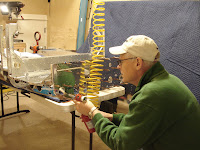



Staying on pg. 21-11 I started this Saturday's building extravanza on step 3. I spent about 4 hours on steps 3-5. It was at least twice as long as necessary because I didn't pay enough attention to which side of the bulkhead to install the Control Column Mount Assemblies and started right off putting the first one on the wrong side. If that wasn't enough, I had used the wedge tool to put the rivets in, and the shanks broke off a good 1/4 inch above the rivet. Correcting this mistake was problematic. To make things even worse, I also had installed the nutplates which were even more challenging to remove. PAY ATTENTION!!! This misstep cost me time and degraded the quality of the build a bit.
Moving on to pg. 21-12 was good. No significant challenges, but again, pay attention to what the plans call out in terms of where to dimple. I took the advice of others and taped off those nutplate holes that were NOT to be dimpled. The challenge on this page is how to position the bulkhead so that you can use the hand squeezer to make the dimples.
Pg. 21-13 is prett straight forward, but I was careful and took plenty of time to read & re-read the riveting instructions. Be sure not to rivet the F-1253 L & R. You will need to work the control column through this location and will need to bend this part of the way to make the fit. On step 5 the plans indicate to final drill the 3/8 inch hole to 1/2 inch. I did this on the drill-press using the uni-bit and it went well. Be sure to do the FORWARD hole as identified.
One question came up in my mind when I got to riveting the seat ramp floors to the F-1215 seat ribs. Some of the ribs that had dimpled holes on the upper flange did not need the dimple as the plans call out using a LP4-3 rivet. Oh well, I hope this is correct.
Finished the night by inserting the control column through the lightening holes. This took a bit of maneuvering, but with gentle persistence it went into place. Tomorrow I'll pick up on pg. 21-14.





























